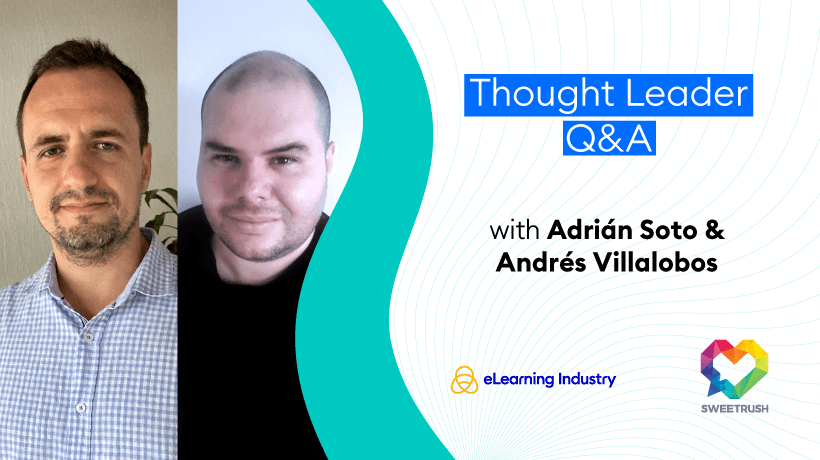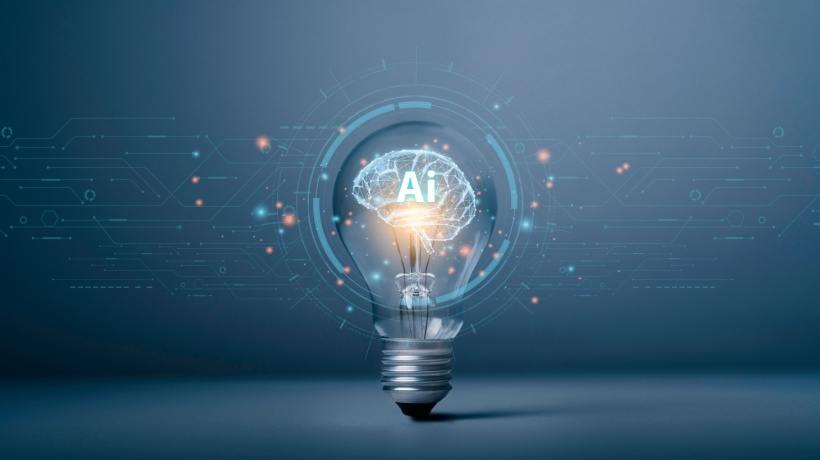Delving Into AI In L&D And Cognitive Computing With Two Industry Experts
Adrián Soto is the Director of SweetRush's AI Strategy. He is well-versed in the ever-changing landscape of emerging and immersive technologies, and at the same time, understands that business and instructional objectives come first. Andrés Villalobos is the AI Engineer Strategist at SweetRush, where he collaborates with cross-functional teams to develop cutting-edge AI and immersive technologies to solve business and learning challenges. As a software engineer, Andrés specializes in bridging the gap between emerging technologies and practical business applications. Today, Adrián and Andrés speak with us about how SweetRush is working with clients to embrace knowledge management, training on AI, and augmented intelligence.
I know SweetRush has begun to do a lot of work with clients related to information or knowledge management. Can you please share a little bit about what you are doing for clients on this topic?
Adrián: Every company possesses an immeasurable treasure trove of information and accumulated knowledge that, thanks to AI, can now be harnessed to create amazing and engaging content in ways we've never seen before. We're excited to be helping clients reap the benefits of making their accumulated knowledge easy to access.
It's great to see AI becoming increasingly accessible, and it's exciting that it offers another way for L&D to lead the charge. To pull this off requires a mix between a heavily technical process and learning design knowledge to guide the output of these systems, and both fall under the umbrella of Context Engineering. Things like prompt design, RAG models, and knowledge bases need to be managed and integrated, and we've developed tools to help in this process. Doing this right demands deep knowledge of how to design learning paths and how people access and learn from information. It's a really exciting time for L&D.
Andrés: We've embraced knowledge management as a strategic service offering, helping organizations transform how they capture, organize, and leverage their institutional knowledge. Our approach focuses on creating comprehensive knowledge ecosystems that make critical information easily accessible and actionable for employees at all levels.
We work with clients to audit their existing knowledge assets, identify gaps and redundancies, and design systems that facilitate knowledge sharing across departments and teams. This includes developing interactive knowledge bases, searchable content repositories, and workflows that capture tacit knowledge from Subject Matter Experts before it's lost. We can create entirely custom systems tailored to specific organizational needs, or develop solutions that seamlessly integrate with existing Learning Management Systems and platforms.
Our knowledge management solutions integrate learning components to ensure that information is both stored and actively used for continuous improvement and skill development. We help organizations establish communities of practice, implement mentoring programs, and create feedback loops that keep knowledge current and relevant. With AI increasingly bridging the gap in understanding complex information, we're also exploring innovative applications that make learning more intuitive and knowledge more discoverable through intelligent search, personalized content recommendations, and automated knowledge extraction.
By combining our expertise in learning design with knowledge management principles and emerging technologies, we enable our clients to build resilient organizations where institutional wisdom is preserved, shared, and continuously enhanced. We can meet organizations wherever they are in their knowledge management journey and scale solutions to match their evolving needs.
Over the past few years, SR has done a great deal of certifications on varied topics, and more recently, you've been doing a significant number of certifications around AI. Can you please speak about that a bit?
Adrián: We've done a lot of certification programs on a variety of topics! At the moment, we're working on six in-depth certification programs focused on technical AI topics.
One ingredient in our secret sauce is our Talent Solutions team's ability to source AI Subject Matter Experts (SMEs) who bring their expertise to our clients. These SMEs' specialties include (to name a few):
- Google DeepMind Technologies
- AI/ML Frameworks: TensorFlow 2.x, PyTorch, multimodal data processing
- RAG Systems: Vector databases (Pinecone, ChromaDB) and data pipelines
- Microsoft Azure AI & Generative AI
One interesting value-add that our team brings to the table with these certification programs is our ability to create custom tools that help in the production process. For example, we have created a tool that allows us to generate content faster while keeping up with production requirements from our clients in areas such as how information needs to be presented and uploaded to their individual systems.
Also, in one of our most recent AI certifications, we created an adaptive, human-centered approach to AI capability building. For this client, we developed critical mental model shifts for the training program, ensuring they directly supported the client's strategic business objectives for AI transformation. This certification had interactive practices, real-time tools, and applications like AI chatbots and an AI assistant/coach.
We've seen the demand for certification programs growing over the last few years, and we think this trend will only continue to ramp up.
It seems that enterprise clients have a need these days to train their people on AI. If you were advising a client on how to approach AI training, what would you say to them?
Adrián: I'd advise them to talk to us! But seriously, Artificial Intelligence is a broad and complex field, and jumping into training without a clear purpose or guidance can quickly become overwhelming.
Effective internal training should be guided by a combination of the company's needs and the individual's capabilities. While it's true that anyone can begin with the fundamentals of AI, that path only goes so far. Eventually, learners are faced with a wide array of directions to take their development.
At this point, I believe the key is to strike a balance between what the company requires and what aligns with the learner's strengths and interests. This balance should inform the direction of further training.
With that in mind, my recommendation is to first assess where the company currently stands in terms of AI maturity. From there, determine the strategic direction it wants to pursue, and then use that insight to decide how to structure training for employees.
Andrés: AI training requires a strategic, grounded approach that cuts through the hype and focuses on practical value. I'd advise clients to start with a clear-eyed assessment of their actual business needs rather than chasing the latest AI trends.
First, establish AI literacy fundamentals across your organization. Many employees need to understand what AI can and cannot do before they can use it effectively. Focus on building critical thinking skills around AI outputs—teaching people to verify, validate, and apply human judgment to AI-generated content.
Second, prioritize proven, stable AI applications over experimental ones. Tools for content creation, data analysis, and process automation have demonstrated clear ROI and are mature enough for enterprise use. Avoid getting distracted by flashy demos of emerging technologies that may not have staying power or clear business applications.
Third, develop robust governance frameworks early, including rigorous validation workflows for AI-generated content. Establish guidelines for data privacy, accuracy standards, and ethical use. Create multi-stage review processes, quality benchmarks, and mandatory human oversight at critical decision points. Build clear accountability chains for AI outputs and feedback loops to capture what's working, allowing you to iterate and improve your implementation strategy.
Finally, integrate AI training with your existing knowledge management and learning systems. AI tools are most effective when they enhance human expertise rather than replace it. Train people to use AI as a complement to their domain knowledge, not as a substitute for critical thinking. Emphasize that validation workflows are essential quality assurance practices that protect your organization's reputation and effectiveness.
The key is building sustainable AI capabilities that align with your organization's goals and values, rather than implementing AI for its own sake. Focus on measurable outcomes and practical applications that your people can master and improve over time, always with robust validation processes ensuring the highest-quality outputs.
Let's get a little nerdy! Can you please share a little bit about the relationship between cognitive computing and augmented intelligence, and AI? I know you believe this is important for L&D leaders to be aware of, so can you please break this down for us?
Adrián: I've noticed that, when we talk about AI, we usually center our discussion on just that term: Artificial Intelligence. However, I feel it's important to really understand what aspect of AI we are talking about.
When we have AI conversations, especially when company strategies and client solutions are involved, we should really focus down to specifics. Doing so helps clarify our communication and, as a result, it's easier to act.
What L&D leaders should know is that the terms cognitive computing and augmented intelligence speak to specific applications of AI.
Cognitive computing is basically an area of AI that specializes in simulating human thought processes in computerized models. For L&D, this could mean, for example, the creation of systems to analyze learners' behavior, preferences, and performance—and adapt content accordingly, in real time.
Another example would be creating a cognitive computing system that mimics a human tutor who provides real-time feedback. We partnered with Hilton to create a system like this for a specific training program. It involved a robot named VIC that used Natural Language Processing (NLP), speech recognition, and an LLM to provide feedback to learners' verbal input. In both examples, we are removing the human component and replacing it with AI.
When it comes to augmented intelligence, things get a little philosophical. It's a very important term, though, because it involves using AI to enhance human intelligence rather than replace it.
When we think about augmented intelligence, we're actually thinking about a human-centered approach to AI. From an L&D perspective, this means our discussion is about the learner first and foremost, not necessarily about AI.
For example, we might ask questions like, How should we augment the learning process? Is it through a mentor, a coach, or a simulation? What is the best way to present the information to the learner? How can AI facilitate this process?
In the Hilton example I mentioned earlier, our cognitive computing conversations center on the technical aspects of VIC the robot, and how it would provide feedback to learners. Our augmented intelligence conversations focused on finding the best method to determine if learners had truly mastered the subject matter. At the end of the day, both conversations were about using AI for Hilton's training, but each one had different approaches with different people and skills involved.
Andrés: I see the concepts of cognitive computing and augmented intelligence as interconnected but distinct, and understanding their relationships is crucial.
Cognitive computing serves as the foundation; it's about creating systems that process information in ways that mirror human thinking patterns. These systems understand context, learn from experience, and handle ambiguity, making them particularly valuable for complex learning scenarios where rigid, rule-based approaches fall short.
Augmented intelligence builds on cognitive computing with a specific philosophy: namely, AI should enhance human capabilities rather than replace them. In L&D contexts, this means designing solutions where technology amplifies human expertise, creativity, and judgment. Think of intelligent tutoring systems that adapt to individual learning styles while keeping human instructors in the loop for nuanced guidance and emotional support.
Traditional AI often aims for automation and independence, but augmented intelligence deliberately maintains human agency and oversight. This distinction is critical for L&D because learning is fundamentally a human process that benefits from empathy, mentorship, and social connection that only humans can provide.
The practical implications for L&D leaders are significant. When evaluating learning technologies, look for solutions that enhance your Instructional Designers' effectiveness rather than replacing them. Seek platforms that analyze learner data to suggest personalized pathways while keeping educators in control of curriculum decisions. Choose tools that automate routine tasks like progress tracking or content curation, freeing your team to focus on high-value activities like relationship building and complex problem-solving support.
This cognitive computing foundation also enables sophisticated knowledge management integration. Systems can understand context and relationships between concepts, making organizational knowledge more discoverable and applicable. They can identify knowledge gaps, suggest relevant experts for consultation, and predict learning needs based on business changes.
The key is maintaining the right balance—leveraging AI's pattern recognition and processing capabilities while preserving the human elements that make learning meaningful, trustworthy, and transformative.
Keeping up on the technical track, what is the difference between augmented intelligence and augmented learning, and really, why should we care?
Adrián: In our previous question, we talked about how augmented intelligence involves using AI in ways that help learners perform better. From a strictly AI perspective, this is where this term ends.
However, there is a much broader term: augmented learning. Augmented learning refers to using any technology, or mix of technologies, to enhance the learning experience. This can include AI as well as other technologies.
A familiar example of augmented learning is when we use immersive technologies such as Virtual Reality and Mixed Reality to make the learning experience more effective. In this case, we are not using AI—though we could—to enhance the learning experience.
In summary, augmented learning is an umbrella term used when we are leveraging any type of technology to enhance the learning experience. Augmented learning includes augmented intelligence, which is a specific philosophy within AI that focuses on supporting and enhancing human thinking rather than replacing it.
Andrés: The way I like to explain it is that augmented intelligence and augmented learning are related, but they address different aspects of how AI enhances human capabilities.
Augmented intelligence is the broader philosophical framework. It's about AI systems that enhance human cognitive abilities rather than replacing them. This approach maintains human agency and judgment while leveraging AI's processing power for tasks like pattern recognition, data analysis, and content generation.
Augmented learning is the specific application of this philosophy to educational contexts. It uses AI to personalize learning experiences, adapt content delivery, and provide intelligent tutoring while preserving the essential human elements of teaching and mentorship. Think of systems that analyze learner progress to suggest customized pathways, but still rely on human instructors for complex guidance, emotional support, and contextual wisdom.
The key difference is scope: augmented intelligence is the overarching approach to human-AI collaboration, while augmented learning is how we apply that approach specifically to skill development and knowledge transfer.
Why should L&D leaders care? Simply put, because this distinction shapes how you evaluate and implement learning technologies. Solutions built on augmented learning principles will enhance your team's effectiveness while preserving the human relationships that make learning meaningful. They'll automate routine tasks like progress tracking or content curation, freeing your L&D team members to focus on high-value activities like creative problem solving and learner engagement.
This approach also ensures better learning outcomes by harnessing both AI's data processing capabilities and human strengths in understanding context, providing empathy, and making nuanced judgments about learning needs.
The practical implication is to seek learning technologies that amplify human expertise rather than bypass it, ensuring the L&D function remains both relevant and impactful in an AI-enhanced world.
Everywhere you hear about AI agents such as chatbots, avatar-type characters, and search tools being added to learning experiences. What are your distilled thoughts about AI agents and how you see them playing out in our world of L&D?
Adrián: An AI agent is an autonomous system that reacts to data input, processes that data, and acts based on a set of goals. For example, a chatbot that helps you with functional quality assurance (FQA), or a tool that provides information relevant to a task you're performing at a specific moment. It's similar to the concept of cognitive computing, except that an AI agent isn't required to act like a human. A cognitive computer system could include multiple AI agents as components within its system.
Our team sees these agents as a fruitful use of AI that holds great promise in helping learners gain proficiency. The ability to ask questions and receive succinct answers via a chatbot while completing training or performing a task would be hugely valuable to learners seeking to fill in knowledge gaps or gain a deeper understanding in a certain domain.
AI agents, as part of cognitive computing systems, interact with learners and offer opportunities to practice customer service, coaching, leadership, or other interpersonal skills in a realistic and intuitive way. A simulated AI coach might review an assignment such as a project plan, proposal, or industry analysis and offer rich feedback (as well as endless patience). We've been applying all of these agents in our work with clients, and we're finding them to be effective, engaging, and extremely cool additions to our L&D toolbox.
Andrés: I would add that there is a strong connection between knowledge bases and AI agents. A company needs to build knowledge bases that integrate its information and connect effectively with AI. Agents are going to be the autonomous systems that interact with these knowledge bases to perform various tasks.
In the future, companies will likely rely on a foundation where AI, applications, and knowledge are all interconnected, with different agents handling specific responsibilities to support the company's operations.
AI agents represent a leap forward in how we think about automated learning support. At their core, AI agents are autonomous systems that can perceive their environment, make decisions, and take actions to achieve specific goals without constant human intervention. What sets them apart from traditional AI tools is their proactive nature and ability to access and operate other applications and systems within an organization. Unlike passive AI systems that respond to queries, agents actively monitor conditions, identify opportunities, and initiate actions across multiple platforms and workflows.
In L&D contexts, AI agents can serve as intelligent learning orchestrators that continuously monitor skill gaps across your organization, automatically curate relevant learning content from multiple sources, and coordinate training interventions. They can function as proactive learning assistants, helping employees navigate complex knowledge bases, connecting them with appropriate mentors based on real-time analysis of expertise and availability, and providing personalized coaching that adapts to individual learning styles and performance patterns.
Their tool-operating capability means AI agents could automatically schedule training sessions, create personalized learning dashboards by pulling data from multiple enterprise sources, update employee profiles based on completed certifications, trigger workflow automations in Learning Management Systems, and initiate cross-departmental collaboration based on identified learning opportunities. They become true learning orchestrators that work across organizational boundaries and systems.
However, it's critical to recognize that while AI agents excel at pattern recognition, data processing, and system integration, L&D fundamentally relies on human elements that agents cannot replicate: empathy, contextual wisdom, creative problem solving, and the ability to understand the subtle dynamics of organizational culture and interpersonal relationships.
My perspective is that AI agents will be most valuable when designed as augmented learning tools rather than autonomous replacements for human L&D professionals. They should handle the heavy lifting of data analysis, content organization, system integration, and routine administrative tasks, while human experts maintain control over strategic decisions, relationship building, and complex learning interventions.
The key is implementing AI agents with robust validation frameworks and clear boundaries that respect both their autonomous capabilities and their limitations. This means designing systems with human oversight at critical decision points, transparent reasoning processes, and the ability for L&D professionals to understand and override agent recommendations when necessary. Given their ability to access and modify data across multiple systems, security protocols and audit trails become especially critical.
Looking ahead, I see AI agents becoming sophisticated learning orchestrators that help scale personalized education while preserving the human connections that make learning truly transformative. The organizations that succeed will be those that thoughtfully integrate these tools to amplify their L&D teams' capabilities, leveraging the agents' autonomous and integrative nature while maintaining human expertise at the center of the learning experience.
Wrapping Up
Thanks so much to Adrián Soto and Andrés Villalobos for fielding our questions and sharing their valuable insights with us. If you'd like to explore the many ways that you can leverage AI in your learning program, check out SweetRush's AI-L&D Continuum. It includes all of the elements you will need to embrace AI, from SME placement to AI skills training.





